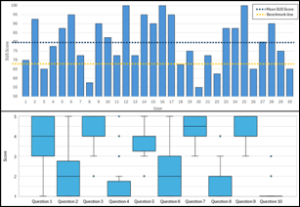From Paper to Electronic Medical Records in Austrian Helicopter Emergency Medical Services: A Usability Evaluation
Aim and Research Question(s)
The aim is to develop and evaluate the usability of an electronic medical documentation app for the Austrian helicopter emergency medical service. The thesis is guided by the following research question: How do healthcare professionals, who are used to paper-based documentation, evaluate the usability of an electronic emergency medical documentation app for the Austrian helicopter emergency medical service?
Background
Efficient and accurate documentation in helicopter emergency medical services is critical for patient outcomes [1]. Traditional paper-based methods have inherent limitations, such as illegible entries, delays in data access, and an increased risk of information loss [2]. These challenges can be mitigated by implementing electronic solutions.
Methods
The application was developed with React Native and iteratively adapted to the specific requirements of the end users in close cooperation with a HEMS-Crew Member. Convenience and purposive sampling were used to recruit 30 healthcare professionals. The evaluation took place in July 2024 and the System Usability Scale (SUS) was used to assess usability. Additionally, qualitative data from open-ended questions were analysed.
Results and Discussion
The results show an average SUS score of 79.92. While older and more experienced users as well as users with excellent digital skills rated the application positively, less experienced and younger users showed a lower level of satisfaction. Four main themes emerged from the qualitative analysis:
- Automation and integration (~30% of all statements)
- Need for improvement and adaptation (~35%)
- Positive attitude towards the application (~54%)
- Simplification and efficiency over existing concerns (~19%)
 Figure 1: Bar chart of individual users SUS-Scores and Boxplot of SUS scores by question
Figure 1: Bar chart of individual users SUS-Scores and Boxplot of SUS scores by question
The Usability would receive a grade of 'A-' in the academic grading system [3]. Inconsistent SUS responses raise questions about the understanding of the SUS statements. The qualitative analysis shows that users want the application to be simple and intuitive to use, but at the same time expect a powerful and integrated solution.
Conclusion
The results underline the importance of continuous optimisation of digital applications in healthcare, which should be closely aligned with the needs of end users. Future developments should therefore focus not only on technical improvements, but also on optimising the user experience.
References
[1] Smith, J., Jakobsson, A., Kain, V. J., Kandasamy, Y., & Bragg, R. (2023). Neonatal electronic resuscitation app documentation (NeRD): Electronic documentation compared to written documentation. Journal of Neonatal Nursing, 29(2), 290-295. [2] Butler, M. J. et al. (2024). Implementation of major trauma app: usability and data completeness. BMC emergency medicine, 24(1), 136. [3] Sauro, J., & Lewis, J. R. (2016). Quantifying the user experience: Practical statistics for user research. Morgan Kaufmann.